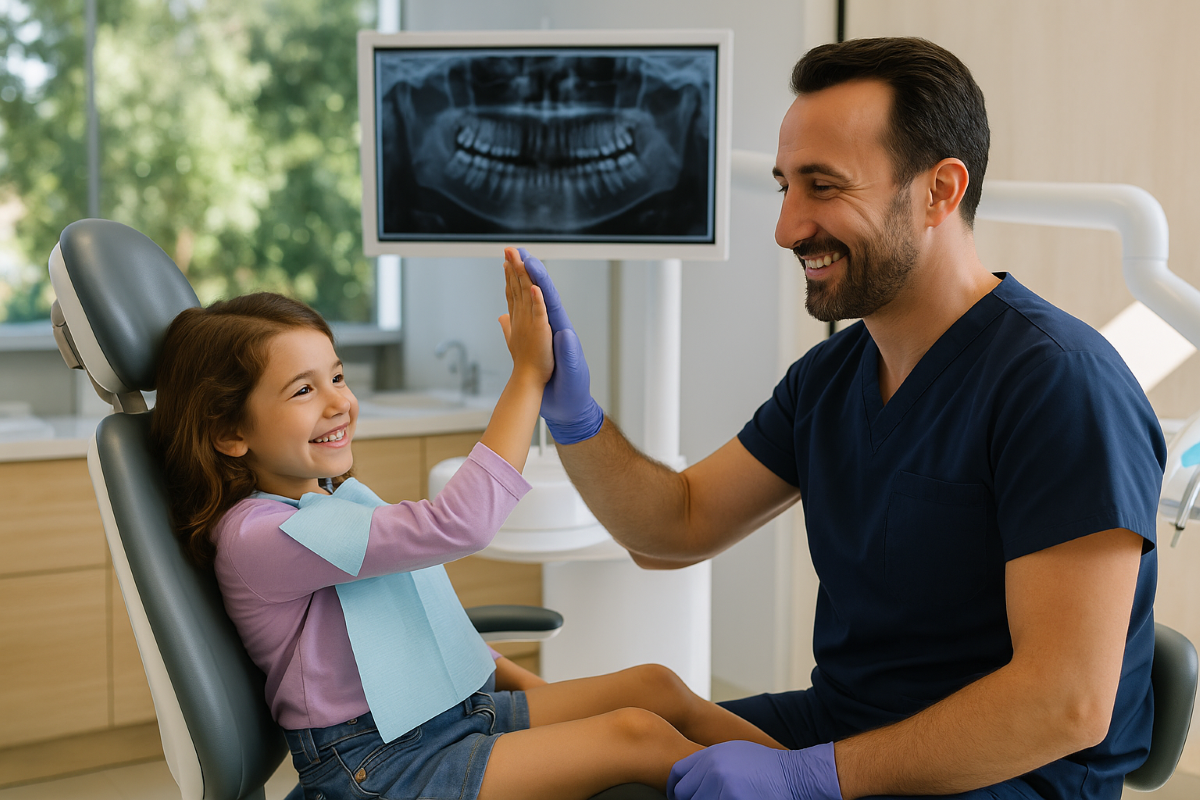Key Highlights of Virtual Receptionists for Dental Clinics
The future of dental clinics is evolving with the rise of virtual receptionists.
Virtual receptionists enhance patient experience by streamlining administrative tasks.
Implementing virtual receptionists leads to cost savings and boosts operational efficiency.
Patient care and satisfaction improve significantly with virtual receptionists.
Seamless integration and staff training are crucial for successful adoption of virtual receptionists in dental practices.
Introduction
The dental industry is changing quickly, and dental clinics are changing how they work. A big step forward is using AI receptionist for dentists. Virtual receptionists are changing how dental practices handle administrative tasks and connect with patients. This change is improving the patient experience and transforming the industry.
The Evolution of Reception in Dental Clinics
The receptionist at a dental clinic plays a very important role. They are usually the first person patients see when they arrive. They handle key administrative duties to keep things running smoothly. As technology changes, the traditional reception desk is also changing. AI receptionist for dentists are now becoming a big help in dental care.
From Traditional to Virtual: A Brief History
Dental practices, like other businesses, have always used in-person receptionists. They manage phone calls, book appointments, and welcome patients. But now, we live in the digital age. This new time brings automation and efficiency. With better software and new communication channels, virtual receptionists can do many tasks that staff used to handle. This change shows how dental clinics are improving their operations.
How Dental AI Assistants Use Technology to Improve Front Desk Operations
The changes in dental clinic reception are closely related to new technology. New software and communication tools have made it easier for virtual receptionists to work in dental offices. They can schedule appointments automatically and use secure messaging systems. This technology helps virtual receptionists handle many tasks well, which improves patient care and makes office work simpler.
Understanding Virtual Receptionists in Dental Clinics
Virtual receptionists are changing the way dental clinics handle patient interactions and day-to-day tasks. So, what are they, and how do they function? It is important for dental practices to understand the main features and advantages of virtual receptionists. They can help clinics make the most of this new technology in managing their administrative tasks.
How a Virtual Dental Assistant Works (Step-by-Step)
A virtual receptionist is a smart virtual assistant designed to do the work a human receptionist would do in a dental office. They use advanced software and artificial intelligence to help manage appointments, answer patient inquiries, and handle other administrative duties. These systems can understand and reply to patient requests through phone calls, emails, or online chats. This helps create a smooth and efficient experience for patients. Patient information is kept safe and organized in the system, making it easy to access for authorized staff while ensuring privacy.
The Benefits of Implementing Virtual Receptionists
The benefits of using virtual receptionists in dental clinics are many. They can help in different areas of managing the practice and improving patient experience. Here are some main benefits:
Cost Savings: Virtual receptionists can automate jobs usually done by staff in-person. This can lower costs related to salaries, benefits, and office space.
Patient Satisfaction: Virtual receptionists are available all day, every day. They help cut down wait times and provide a personal touch, making patients happier with the service they get.
Operational Efficiency: They can take care of tasks such as appointment scheduling, reminders, and insurance verification. This makes work easier, lowers the chance for mistakes, and lets staff spend more time on patient care.
The Impact of Virtual Receptionists on Patient Experience
One big impact of virtual receptionists in dental clinics is how they improve the patient experience. When a patient reaches out to book an appointment, virtual receptionists are there to help. They also send timely reminders and follow-ups. This change is making it easier for patients to connect with dental care providers.
Enhancing Customer Service and Accessibility
Virtual receptionists are available 24/7. This means patients can get information, schedule appointments, or ask questions anytime, even outside office hours. This easy access cuts down wait times and helps patients get more involved in their dental care. Virtual receptionists provide quick responses and personal service. They are important for giving quality care and improving patient satisfaction.
Streamlining Appointment Scheduling and Reminders
Managing appointments well is very important for a dental practice. Virtual receptionists are very good at this. They help make the scheduling process easier. They can quickly handle appointment booking, cancellations, and rescheduling based on what is open. This helps make everything smooth for both patients and dental staff. Also, they send timely reminders to patients using different communication channels. This helps to lower no-shows and keeps patients updated about their appointments. In the end, this leads to better patient communication and helps them stick to their treatment plans.
Integrating Virtual Receptionists into Your Practice
Incorporating virtual receptionists into a dental practice needs good planning. It is important to think about everything carefully. You must choose the right software. Training your staff is also key. You should address any concerns that might come up. A smart approach will help you get the most benefits from this new technology.
Key Considerations for Seamless Integration
Before using virtual receptionists, you need to look at what your dental office really needs. Choose virtual receptionist software that works well with your current systems, like patient management and scheduling systems. It is important to train your staff members on how to use the new system and deal with any technical issues. Good communication with patients about the new virtual receptionists is very important. Make sure to share the benefits of this change and address any concerns they might have for a good response.
Training Staff to Work Alongside Virtual Assistants
To use virtual receptionists in a dental office, staff members need proper training. They should learn how to work with these digital assistants. This means getting to know the virtual receptionist software, its features, and how to share tasks. It is important to stress how these virtual assistants can help improve patient care and make work easier. This can ease any worries the staff might have. Ongoing training and support will help everyone adjust well. This ensures that the dental virtual assistant is used to its full potential, bringing many benefits.
Addressing Concerns and Challenges
While virtual receptionists offer many benefits, we must look at possible concerns and challenges when using them. Data security is important. We also need to think about patient privacy. Finally, we should consider how staff and patients feel about this new technology. All these factors need careful thought and management.
Privacy and Security in the Age of Digital Reception
In today’s world, we depend more on digital systems than ever. Protecting the privacy and safety of sensitive patient information is very important. Dental practices should focus on data security when using dental AI assistant. They need to choose software that follows HIPAA rules and set up strong cybersecurity measures. This means they should encrypt patient data, use secure communication channels, and train staff on how to protect data. By following best practices in the industry and sticking to healthcare regulations, patient records can stay safe. This helps build trust and confidence in the digital reception system.
Overcoming Resistance to Change Among Staff and Patients
Implementing new technologies, like dental AI assistant, can face some pushback from staff and patients. It’s important to address this pushback early for things to go well. Telling everyone about the benefits of virtual receptionists is key. This includes better efficiency, shorter wait times, and easier access.
Training staff members to use the new system is also vital. Providing support during the change can help them adapt better. For patients, it’s helpful to point out the benefits too. Virtual receptionists are available 24/7 and can make appointment scheduling much easier. This can lead to a more positive view of these new healthcare practices.
Conclusion
The use of AI receptionist for dentists in dental clinics is a big step forward. This change helps make the patient experience better and boosts operational efficiency. With technology, clinics can make appointment scheduling easier, improve accessibility, and offer great customer service. However, it’s important to think about issues like privacy and staff being unsure about change. Using virtual receptionists can change how clinics work with patients, leading to better satisfaction and loyalty. As we move into the future, bringing virtual receptionists into your clinic will help it stand out in the world of dental care.
Frequently Asked Questions
What Can Virtual Receptionists Handle Beyond Greeting Patients?
Virtual receptionists can do many tasks. They can check insurance details. They answer patient queries about office hours and healthcare services. They also do data entry and manage appointments. Their work goes beyond just greeting people. They play a big role in making operations run smoothly.




